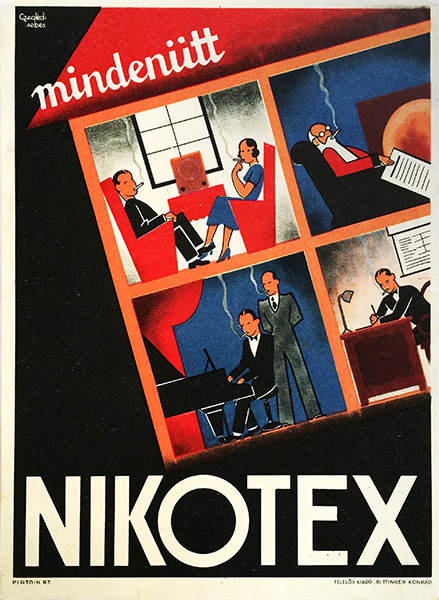
Description:
Decorative art deco tram poster by Istvan Czegledi and Janos Sebes. In the 1930s the two artists often work together. This peiod also marked the beginning of the poster designer career of Czeglédi.
In the 1930s big companies discovered the strength of advertising with posters and beautiful posters appeared all over the streets. Tobacco companies also contributed to this trend as at the time there were no legal constraint of advertising smoking. The major tobacco companies of the time were Modiano, Senator and Nikotex, and the most prominent artists were commissioned to design posters for them, for example Sándor Bortnyik, Róbert Berény or Gyula Macskássy. Modiano was famous for its beautiful modernist and later art deco posters and it wasn't easy for Nikotex creating something different but equally decorative and easy to identify with the brand. Finally Nikotex managed to come up with grandiose designs.
Nikotex used other means besides advertisments to differentiate itself from the competition: in the 1930s they reduced the nicotone in their products. Many of their posters chose this asset to focus on in the advertisments. At the time Nikotex was considered the less harmful but more expensive brand available on the tobacco market. Interestingly, it was not the contemporary attitude to deal with the concerns related to smoking. Hungary has been producing cigarettes since 1865 and attempts had been made by the turn of the century to produce less harmful cigarettes. However, filtered cigaretts weren't made until 1962 in Hungary. Nikotex was established in 1930 with the goal of finding a solution to subtract nicotine from the cigarettes. After years of researching they did manage to produce less harmful cigarettes but not by filtering the smoke but by reducing the nicotine in tobacco. Soon many tobacco production companies started to produce classic and Nikotex versions. This was when the classification of tobacco products that are still in use today was created, namely when one brand offers more types of one product, such as, strong, medium or light. Moreover, cigarette brands started to use the colours still in use today for labeling the strength of their products (red for the stronger, blue for the lighter). In those times tobacco related advertisments were very common, and not only posters were used for this purpose but advertising slips as well. Nikotex has remained very popular until the end of the 1950s which can mainly be accounted to the fact that it wasn't much more expensive then general cigarettes and - according to the attitude of the time - it was less harmful.
This beautiful art deco Nikotex poster does not focus on health but on the fact that it can be smoked anywhere. Art deco can be described as the mixture of modernism and orientalism. The diagonal construction of this poster carries the modernist stylistic elements, while the gentle wavy lines indicating the smoke are rather oriental. Art deco was most popular among the gentry class, therefore the four sceneries depicted by this work are pictured in typical gentry environments. The blue and red colours remind the viewr to the Bauhaus style, but as it is combined with more subtle, pastell colours, and shades at some parts, in front of a black background it becomes a rather elegant art deco piece arranged in a way typical of modernism.











